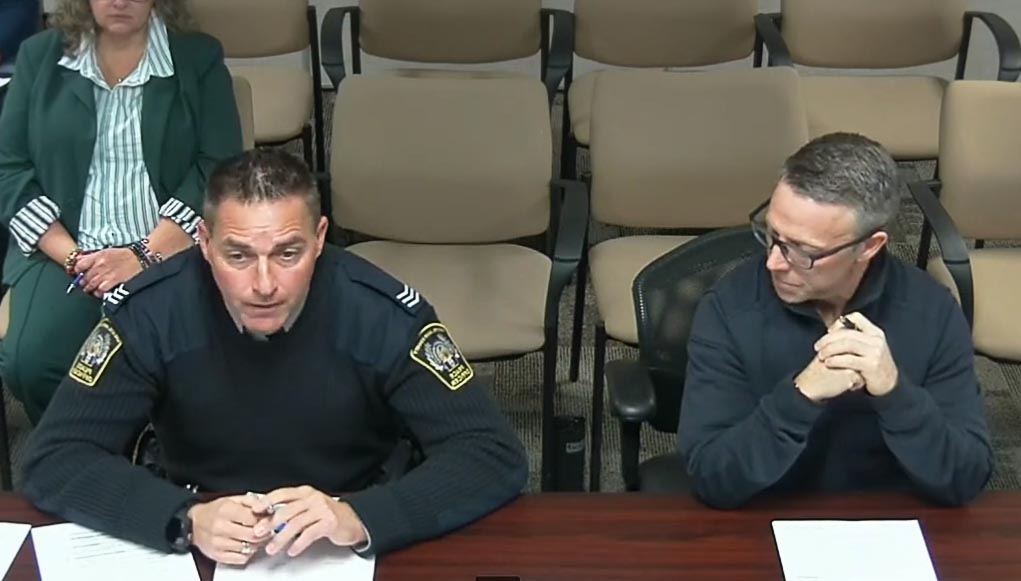Early this year, on February 1, Woodlands County and Lac Ste Anne County (LSAC) entered into a five-
year contract to see the Lac Ste Anne County’s peace officers provide 80 hours of Enforcement Services
to Woodlands County each month. Woodlands County is also to receive monthly reports on
Enforcement Services supplied by LSAC, giving the County a picture of what services are provided and
when.
On October 25, LSAC Community Peace Officer and Supervisor Sargent Dallas Choma and Sheldon
Schoepp, Manager of Protective Services for Woodlands County, presented the third quarter (Q3)
overview for Woodlands County Council. “At the time this was drafted, our enforcement department
from Lac Ste Anne County issued two orders in Q3,” began Sargent Choma. “They were clean-up orders,
forcing people to clean up their property or tear down some sort of derelict building. We’ve done
extremely well with our orders out in Woodlands County.”
Ticket-wise, Sargent Choma said officers wrote 51 tickets, totalling $11,697. He then explained that 47
percent of the fine value goes to the province. There were also four written warnings given out within
the County. The value of the fines, had they been tickets and not warnings, was $748. Between the
tickets and written warnings, there was a total of 55 tickets given out in Q3.
The highest number of tickets given out was to those exceeding the established speed limit, with 34
tickets. The next highest (4) was for those operating a motor vehicle without the proper paperwork. The
remaining citations with three or fewer tickets included windshields with cracks in the viewing area,
driver not wearing a seatbelt, failure to produce an operator’s license, a dog that had
bitten/attacked/threatened, crossing a double solid lane line, speeding on the highway, unsecured
license plate, accumulation of offensive material and exceeding the allowable number of dogs.
Sargent Choma said that through the third quarter, they responded to 18 incidents. The types of
incidents responded to included Animal Control Bylaw, Dog Bylaw, Noise Bylaw, Priority 1 and Priority 2,
Traffic Safety Act, Unsightly Property, Dangerous Dog and Assist Fire Call. The two types with the highest
incident count were Dog Bylaw complaints and Priority 2, both with four. The rest of the incident types
had a count of either one or three.
He explained that the Priority 1 and Priority 2 incident types would not be used again from now on in
favour of more specific terms. He said the priority wording had previously been used as a catch-all for
incidents outside the basic terms. “When Lac Ste Anne County moved into the new software, which is
the software you see here for reporting and enforcement, a lot of the drop-down menus (for types of
incidents), we had to modify.”
He said when an officer went out to a call and the type of incident they were dealing with wasn’t
reflected in the available drop-down menu for incident type selection, the officer would put it under
either Priority 1 or 2. “We’ve come back into the program, and we’ve modified that so you will not see
Priority 1 or Priority 2 calls again,” he clarified. Officers now have more items to choose from, which will
provide more detail in future reports.
Sargent Chora said that of the incidents dealt with, two had concluded, one with a charge and one with
a warning. He said none of the incidents had required forwarding to another agency. “The RCMP never
got any forwarding of any calls to assist us or to something we couldn’t deal with, which is a good thing.”
Six incidents remain under investigation, while one is listed as unfounded and another as “no status.”
Once he concluded his Q3 report, Sargent Chora said that Lac Ste Anne County had started a pilot
project for Q4, which involved increasing stops. “I would like to see more warnings and tickets issued, so
more stops made if possible. It’s pretty tough here in the County because you’re so far extended, and
there’s only so much pavement where a lot of traffic goes, East Mountain Road, stuff like that,” he
explained. He added that one of the areas receiving higher enforcement was the transport trucks and
speeders coming in and out of the sawmill plant.
Councillor Wilhelm asked how it worked when dealing with unsightly properties. He said he had been
asked about the issue before by residents and said he also wanted clarification for himself. Sargent
Chora noted that if a complaint for unsightly property comes in, officers will investigate it. From there, a
file is generated, and if a clean-up or work on a property is needed, they will issue an order to show the
seriousness of the situation. “If we don’t issue orders right away, then they (think) nothing’s going to be
done,” he explained. He said if the homeowner is doing work on the issue but needs more time, they try
and work with them, granting extensions if necessary. “We try and work with them as much as we can
instead of penalizing. The economy is tough out there,” he said.
Sargent Chora said they try to strive for voluntary compliance but that depending on the homeowner,
the process can take several weeks. Once an order is issued, a ratepayer has a chance to appeal, which
can extend the process further. If the homeowner doesn’t rectify the property, it can result in the issue
being fixed on their behalf. Sargent Chora said calls aren’t typically for agriculture properties but more
for subdivision areas where a homeowner might have many vehicles, including derelict, uncut grass, and
garbage strewn about.
He recommended residents contact them directly through 1-866-880-5722 rather than using the
County’s Service Tracker program. He said the process seemed to move a bit faster that way. He called
the tracker a “grey area where we do not want to go” because of concerns about information collected
in it. “The Service Trackers are helpful when it comes to complaints coming from you guys (Council and
Administration) because then it’s tracked through Sheldon (Schoepp, Manager of Protective Services)
and myself, but the general public, the ratepayers, I would like them to go through (1-866-880-5722) our
office.”








More Stories
Gearing up for another season of cars, cruising and camaraderie
Big dreams lead a talented local youth to Nashville
It’s Youth Week in Whitecourt until Friday